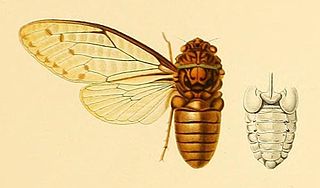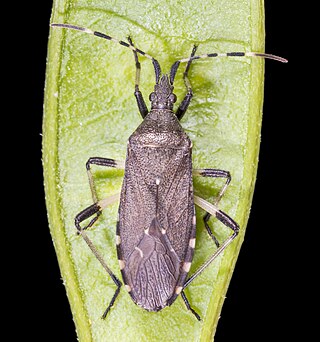
Trialeurodes is a large genus of whiteflies in the family Aleyrodidae.

Hyllus is a genus of the spider family Salticidae. Most species occur in Africa and Madagascar, with many in Australasia and north to India. H. insularis is found in Greece and Iran, but it is considered misplaced in this genus, and is now Evarcha insularis.

Rhene is a spider genus of the family Salticidae.

The Polyceridae are a taxonomic family of sea slugs, dorid nudibranchs, marine gastropod mollusks within the superfamily Polyceroidea.

Naucoridae is a small family of insects commonly known as the creeping water bugs and saucer bugs. They are similar in appearance and behavior to Belostomatidae, but considerably smaller, at 0.5–2 cm (0.2–0.8 in) long. Naucoridae are found around the world, but the greatest diversity is in tropical regions. They inhabit a wide range of freshwater habitats, ranging from still waters like ponds, to flowing rivers and even torrential streams. There are about 400 species in 46 genera in 8 subfamilies.

Ricaniidae is a family of planthopper insects, containing over 400 species worldwide. The highest diversity is in tropical Africa and Asia and in Australia, with a few species occurring in the Palearctic and Neotropical realms. It is one of the smaller families in the planthopper superfamily Fulgoroidea.

Bembidion is the largest genus of beetles in the family Carabidae by number of species. All species are small and move very fast. Most of them live close to water. The genus has a biantitropical distribution, meaning they are found in both the Northern and Southern Hemispheres, but not in the tropics. In warmer regions it is substituted by closely related Tachys and other genera.

Rhynocoris is a genus of assassin bug, family (Reduviidae), in the subfamily Harpactorinae. Species are recorded from Asia, mainland Europe, Africa and North America.
Putoidae is a family of scale insects commonly known as giant mealybugs or putoids. There is probably a single genus, Puto, containing about sixty species. The genus name Macrocerococcus has also been used but it is now considered to be a synonym of Puto. The genus Puto was formerly classified as a member of the Pseudococcidae; however, it so significantly differed from the rest of the Pseudococcidae that it was accorded its own family Putoidae.
The scale insect genus Margarodes is a group in the family Margarodidae. The type species is Margarodes formicarum. The genus was erected in 1828 by Lansdown Guilding who found these waxy "pearls" in the soil on the island of Bahama, associated with ants, and named a species Margarodes formicarum.

Eurymela distincta is a species of leafhopper native to the Australian continent. It has a wedge-shaped body that is 10–12 mm long or 12–14 mm long. The head is black with cream or white maxillary plates. The pronotum and scutellum are black. The tegmen is black with a blue or purple tinge, and one to three white fasciae. The costal margin is black. Legs are scarlet close to the body and black further away. Underparts are scarlet.

Leptopsaltria is a genus of cicadas from Southeast Asia and typical of the tribe Leptopsaltriini.
Arhyssus is a genus of scentless plant bugs in the family Rhopalidae. There are about 14 described species in Arhyssus.
Melanaethus is a genus of burrowing bugs in the family Cydnidae. There are about 15 described species in Melanaethus.
Althos is a genus of leaf-footed bugs in the family Coreidae. There are more than 20 described species in Althos.
Tominotus is a genus of burrowing bugs in the family Cydnidae. There are about 11 described species in Tominotus.

Limnogonus is a genus of water striders in the family Gerridae. There are 28 described species in Limnogonus. Similar to other gerromorphan bugs, most species of Limnogonus have both macropterous specimens, which means that they are often able to fly. The wings are thought to be an adaptation to help the insects get away from drought allowing them to fly to the next available area that has water bodies when the rainy season arrives

Dicranocephalus is the sole genus of true bugs in the family Stenocephalidae. There are about 30 described species in Dicranocephalus.
Geotomus is a genus of true bugs belonging to the family Cydnidae.











